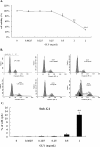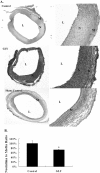A Chinese herbal formula "Gan-Lu-Yin" suppresses vascular smooth muscle cell migration by inhibiting matrix metalloproteinase-2/9 through the PI3K/AKT and ERK signaling pathways
- PMID: 22920190
- PMCID: PMC3475136
- DOI: 10.1186/1472-6882-12-137
A Chinese herbal formula "Gan-Lu-Yin" suppresses vascular smooth muscle cell migration by inhibiting matrix metalloproteinase-2/9 through the PI3K/AKT and ERK signaling pathways
Abstract
Background: This study was to explore the effects of Gan-Lu-Yin (GLY) on the migration of vascular smooth muscle cells (VSMCs) induced by fetal bovine serum and on neointima formation in a rat model of carotid artery balloon injury.
Methods: VSMCs were treated with different concentrations of GLY, and then analyzed with Flow cytometric analysis, zymography, transwell, and western blotting. SD rats received balloon-injury were analyzed with H&E staining.
Results: Our results showed that GLY significantly decreased the thickness of neointima. The inhibition by non-cytoxic doses of GLY of VSMCs migration was through its negative regulatory effects on phosphorylated ERK1/2, PI3K/AKT, and FAK. The data showed that GLY can inhibit the migration of VSMCs cells, and might block injury-induced neointima hyperplasia via the inhibition of VSMCs migration, without inducing apoptosis.
Conclusions: These observations provide a mechanism of GLY in attenuating cell migration, thus as a potential intervention for restenosis.
Figures





Similar articles
-
Demethoxycurcumin, a major active curcuminoid from Curcuma longa, suppresses balloon injury induced vascular smooth muscle cell migration and neointima formation: an in vitro and in vivo study.Mol Nutr Food Res. 2013 Sep;57(9):1586-97. doi: 10.1002/mnfr.201200462. Epub 2013 Mar 21. Mol Nutr Food Res. 2013. PMID: 23520190
-
Anti-Restenotic Roles of Dihydroaustrasulfone Alcohol Involved in Inhibiting PDGF-BB-Stimulated Proliferation and Migration of Vascular Smooth Muscle Cells.Mar Drugs. 2015 May 15;13(5):3046-60. doi: 10.3390/md13053046. Mar Drugs. 2015. PMID: 25988521 Free PMC article.
-
Galangin inhibits neointima formation induced by vascular injury via regulating the PI3K/AKT/mTOR pathway.Food Funct. 2022 Nov 28;13(23):12077-12092. doi: 10.1039/d2fo02441a. Food Funct. 2022. PMID: 36367287
-
Liraglutide attenuates high glucose-induced abnormal cell migration, proliferation, and apoptosis of vascular smooth muscle cells by activating the GLP-1 receptor, and inhibiting ERK1/2 and PI3K/Akt signaling pathways.Cardiovasc Diabetol. 2015 Feb 7;14:18. doi: 10.1186/s12933-015-0177-4. Cardiovasc Diabetol. 2015. PMID: 25855361 Free PMC article.
-
HOTTIP knockdown inhibits cell proliferation and migration via regulating miR-490-3p/HMGB1 axis and PI3K-AKT signaling pathway in ox-LDL-induced VSMCs.Life Sci. 2020 May 1;248:117445. doi: 10.1016/j.lfs.2020.117445. Epub 2020 Feb 19. Life Sci. 2020. PMID: 32081664
Cited by
-
Genistein inhibits tumor invasion by suppressing multiple signal transduction pathways in human hepatocellular carcinoma cells.BMC Complement Altern Med. 2014 Jan 16;14:26. doi: 10.1186/1472-6882-14-26. BMC Complement Altern Med. 2014. PMID: 24433534 Free PMC article.
-
Aralia armata (Wall.) Seem Improves Intimal Hyperplasia after Vascular Injury by Downregulating the Wnt3α/Dvl-1/β-Catenin Pathway.Biomed Res Int. 2021 Jul 12;2021:6682525. doi: 10.1155/2021/6682525. eCollection 2021. Biomed Res Int. 2021. PMID: 34337044 Free PMC article.
-
Traditional Chinese Medicine in Patients With Primary Sjogren's Syndrome: A Randomized, Double-Blind, Placebo-Controlled Clinical Trial.Front Med (Lausanne). 2021 Sep 28;8:744194. doi: 10.3389/fmed.2021.744194. eCollection 2021. Front Med (Lausanne). 2021. PMID: 34651000 Free PMC article.
-
Anti-inflammatory effect of Ganluyin, a Chinese classic prescription, in chronic pharyngitis rat model.BMC Complement Med Ther. 2020 Aug 28;20(1):265. doi: 10.1186/s12906-020-03057-5. BMC Complement Med Ther. 2020. PMID: 32859182 Free PMC article.
-
Ursodeoxycholic acid inhibits intimal hyperplasia, vascular smooth muscle cell excessive proliferation, migration via blocking miR-21/PTEN/AKT/mTOR signaling pathway.Cell Cycle. 2020 Apr;19(8):918-932. doi: 10.1080/15384101.2020.1732514. Epub 2020 Mar 22. Cell Cycle. 2020. Update in: Cell Cycle. 2022 Apr;21(8):881. doi: 10.1080/15384101.2022.2046824. PMID: 32202193 Free PMC article. Updated.
References
Publication types
MeSH terms
Substances
LinkOut - more resources
Full Text Sources
Other Literature Sources
Miscellaneous

